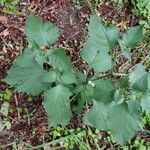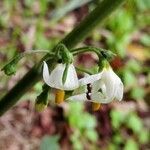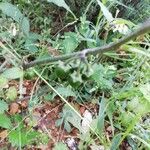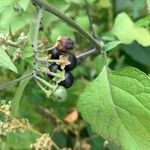Unarmed, annual or short-lived perennial herb to c. 75 cm tall, usually hairy, sometimes nearly glabrous; stems branched, usually green, sometimes dark purple. Petioles to 7 cm long. Lamina c. 2-12 × 1-7 cm, ovate or lanceolate-ovate, entire, sinuate to coarsely dentate, sometimes lobulate, sometimes purple-tinged; hairs usually scattered, short, simple, occasionally glandular; base cuneate to narrowly attenuate; apex acute or obtuse. Cymes pseudoumbellate, usually few-flowered and with at least 1 pedicel arising below peduncle apex; peduncles generally 1-2.5 cm long; pedicels becoming deflexed at fruiting. Calyx 1-3 mm long; lobes ovate, broad-ovate, to almost elliptic, accrescent and appressed to fr. Corolla 10-13 mm diam., usually white, sometimes pale mauve; lobes almost triangular, ± puberulent outside. Anthers 2-2.7 mm long. Berry 7-10 mm diam., globose, usually black and rather dull, sometimes green, yellowish green or pale yellow; stone cells usually 0. Seeds 1.7-2.4 mm diam., broad-obovoid, ellipsoid-obovoid to suborbicular.
Plants subglabrous to villous annuals up to 70 cm high, covered with simple multicellular hairs with glandular or eglandular heads. Stems decumbent to erect. Leaves ovate, ovate-lanceolate, ovate-rhombic to lanceolate, 2.5-7.0 cm long x 2.0-4.5(6.0) cm broad, margins entire to sinuate-dentate. Inflorescences simple, lax and often extended cymes, (3)5 to 10-flowered; peduncles (8)14-28 mm fruiting when usually erecto-patent; pedicels much shorter, recurved in fruit. Calyces 1.2-2.5 mm long, slightly accrescent, deflexed or adhering to base of mature berry, sepals usually ovate. Corollas stellate, white with translucent basal star, (4)5-7(9) mm radius, usually 1.5-3 times as long as calyx. Anthers yellow, 1.5-2.5(2.8) mm long. Styles 2.8-3.5(4.5) mm long, not exserted beyond anthers. Berries usually broadly ovoid, dull purple to blackish or yellowish-green, 6-10 mm broad, remaining on plants or falling from calyces when ripe. Seeds 1.7-2.4 mm long, (15)26-60(96) per berry. Sclerotic granules absent.
Variable, erect herb, annual or short-lived perennial, much branched, up to 0.85 m high, glabrescent to villous, hairs eglandular. Stems ridged, ± dentate. Leaves ovate-elliptic or-lanceolate, up to 80 x 40 mm, margins entire to serrate-repand, glabrescent; petioles up to 30 mm long, ± winged. Inflorescence 5-10-flowered cymes; peduncle erecto-patent, ± 15 mm long; pedicels up to 10 mm long, recurved in fruit, deflexed. Calyx 1.5-2.0 mm long, lobes triangular, up to 1 mm long. Corolla stellate, 8-18 mm in diam., lobes acute, white. Flowering time mainly Oct.-Apr. Fruit ovoid-globose, 5-10 mm in diam., dull, purple to ± black; stone grains 0-2. Seeds 25-35 per fruit, 1-2 mm, fawn.
Herb or short-lived perennial shrub, dark green or purple-green, pubescent with glandular and simple, non-glandular hairs; prickles absent. Leaves ovate, the lamina up to 13 cm long and 7 cm wide, concolorous, entire or shallowly lobed; petiole 1–3 (occasionally to 7) cm long, narrowly winged in upper portion. Inflorescence short, 4–12-flowered; peduncle 1–2 cm long; pedicels c. 7 mm long. Calyx 1.5–2.2 mm long; lobes triangular, 0.3–1.2 mm long. Corolla stellate, 8–12 mm diam., white. Anthers 2 mm long. Berry globular, 6–8 (sometimes to 11) mm diam., dull black or purple-black; fruiting peduncle sharply deflexed. Seeds 1.8–2.2 mm long, fawn.
An erect branched smooth herb. It grows about 60-100 cm high. The stems are green and 3 angled. Leaves are pointed at both ends. The leaves are 1.3-9 cm long by 0.5-6 cm wide. They are oblong and taper to the tip. They can have wavy lobes. The inner ring of petals are white and about 8 mm across. The fruit are black, smooth and round. They hang downwards. Some people claim it is possibly now Solanum americanum.
Leaves solitary or sometimes paired; petiole 0.3–6.5 cm long, ± narrowly winged distally; lamina 2–14 × 0.7–7.3 cm, elliptic to ovate-lanceolate or ovate, base sub-truncate or rounded to cuneate, oblique, ± decurrent into the petiole, apex acute or obtuse, ± acuminate, entire to sinuate-dentate, both surfaces ± pubescent, with more numerous hairs along the veins and towards the margins, glabrescent.
Annual or biennial herb, up to 0.85 m high. Spines absent. Leaves petiolate; blade ± broadly elliptic to ovate, ± 65 x 40 mm, apex acute, base cuneate, margins sinuate-dentate or entire, ± pubescent with simple hairs. Flowers: in few-flowered, umbellate cymes, randomly arranged on stem; corolla 10-14 mm in diameter, white; Oct.-Jul. Fruit a black, rarely red or yellow berry, 6-7 mm in diameter.
Erect, branched annual, up to 0.85 m tall. Leaves petiolate, lanceolate to elliptical, up to 120 mm long, entire to serrate, ± glabrous to hairy. Flowers few, in ± drooping umbels, 10-14 mm diam., white, sepals deflexed or adhering to base of mature berry. Ripe berries dull purple to blackish, broadly ovoid, 6-10 mm in diam., held in drooping clusters from outspread peduncles, edible (as jam).
Calyx 1.2–2.5 mm long, campanulate, in fruit elongated to 3.5 mm; lobes 0.3–1.2 × 0.3–1.2 mm, obovate, semi-elliptic or ovate to ± triangular, rounded to acute, sparsely pubescent with more numerous hairs towards the apex outside, in fruit enlarged to 3 × 2 mm, appressed or scarcely reflexed.
Erect or widely spreading annual to short-lived perennial, sometimes forming dense clumps up to 2 m across and 1.5 m high, (5)25–70(150) cm tall, sometimes flushed with purple, pubescent to villous with simple, curved, usually appressed, eglandular or glandular hairs, glabrescent.
Cymes lateral, unbranched, lax and often extended, (3)5–10-flowered; peduncle 0.3–2 cm long, slender, erect or ascending, in fruit occasionally elongated a little, ascending to deflexed; pedicels 3–8.5 mm long, slender, decurved to ascending, in fruit elongated to 12 mm, deflexed.
Corolla white, cream or yellowish, with or without a conspicuous yellow-green eye, rarely flushed with purple or pale blue, (4)5–7(9) mm across, rotate or stelliform; lobes 1.5–4 × 0.8–2.3 mm, oblong or ovate to lanceolate, rarely linear, ± acute, puberulous outside.
Annual or biennial herb, up to 1 m high, unarmed. Leaves sinuate-dentate or rarely entire, pubescent with simple hairs. Flowers in umbellate cymes. Corolla 10-14 mm in diameter. Fruit black, rarely red or yellow. Flowers white.
Fruits often dull, black or purplish-black to yellow-green, opaque, 6–10 mm in diameter, usually broadly ovoid, smooth, usually without sclerotic granules, glabrous, edible when mature.
Ovary c. 1 mm in diameter, ± globose to ellipsoid, glabrous; style 2–4.5 mm long, straight or sigmoidal, the stigma level with the tip of the anthers or protruding by up to 2 mm.
Glabrous to thinly hairy annual to 1 m. Leaves soft, ovate-lanceolate, often toothed, to 10 cm long. Flowers 5-10 in clusters, white, to 5 mm diam. Berries black, to 10 mm diam.
Seeds with light bone-colour and sometimes flushed with purple, 1.7–2.4 mm long, ± obovate in outline, minutely pitted all over.
Branches ± angular to narrowly winged, the edges smooth or with widely spaced short teeth or prickle-like hairs.
Stamen filaments 0.3–1.5 mm long; anthers 1.5–2.5(2.8) mm long, oblong.
A weed 1-2 ft. or more high, sometimes cultivated
Berries 1/4-3/4 in. diam.
Small white flowers












